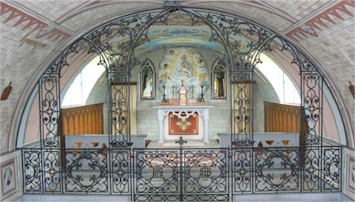
Tuesday, September 22, 2009
The Italian Chapel on Orkney Island is an Icon
An Italian Chapel built by Italian POW from blazing North Africa is one of the greatest icons of hope and peace to come out of WWII. Orkney Islands sits on the most northern east freezing tip of Scotland, and is the location of Scapa Flow, the site of the British Naval Base to guard the North Sea during both World War I &II. Italian POWs were used to reinforce the Base by building the Churchill Barriers.
The Italian Chapel: a Symbol of Hope
A church built by Italian prisoners of war in Orkney is an extraordinary testament to the power of the human spirit
The London Guardian; Philip Paris; Tuesday 22 September 2009
 |
| The interior of the Italian Chapel, Orkney, Scotland. Photograph: Philip Paris |
The Italian chapel on Orkney is one of the greatest icons of hope and peace to come out of the second world war. The first time I entered the building was in August 2005 and I decided there and then to find out as much as possible about it. This turned out to a journey the likes of which I doubt I will ever walk again.
The chapel had been built by Italian prisoners of war, who were transported from the heat of the North African desert for the freezing cold of an Orkney winter at the beginning of 1942. Around 500 were sent to Camp 60 on the tiny island of Lamb Holm in order to work on the famous Churchill Barriers, sealing the eastern entrances to Scapa Flow, harbour of the British Home Fleet.
Within weeks the Italians went on strike - no small thing when you're a POW. They did go back to work, but despair, loneliness and the constant fear for the safety of loved ones back home wore down men's spirits. They filled their spare time with music and hobbies, playing billiards on tables made out of leftover cement, performing plays on the makeshift stage in the mess hall. But they craved a nobler activity.
The arrival of a priest in September 1943 was the catalyst to transform an idea, already in the minds of many, into reality. The British authorities arranged for two Nissen huts to be moved to the camp and these were joined together. Balfour Beatty donated the concrete for the foundations and a local Orkney artist later provided brushes and poster paints.
Building the chapel became the Italians' escape to cultural and spiritual freedom while their bodies remained in captivity. Former enemies became friends. The chapel was completed in late summer 1944 and on 9 September, everyone in Camp 60 was moved. After the war, the demolition team sent to take down the camp refused to touch the converted Nissen hut, with its lanterns made from bully beef tins, and it was left alone in the field.
Today the chapel is known around the world. Some 90,000 visitors a year gaze upon the image of the Madonna and Child above the altar. There's nothing else there, no tea rooms or souvenir shops, not even someone to collect money. Its creation and survival is one of the most inspiring stories to come out of the second world war. Fifty years after arriving at Camp 60, ex-POW Bruno Volpi wrote:
What is it that made prisoners of war work so feverishly with partially or totally inadequate means at their disposal? It was the wish to show to oneself first, and to the world then, that in spite of being trapped in a barbed wire camp, down in spirit, physically and morally deprived of many things, one could still find something inside that could be set free.
I never met Bruno Volpi. I wish I had, but by the time I had started my research he was too frail to help. His words live on. And so does the chapel. The son of another ex-POW from Camp 60 said to me "The chapel is a moving, never-ending story." He is right. Members of the next generation and the one after it are forming links because of a building their fathers or grandfathers created.
This symbol of the human spirit's ability to lift itself out of great adversity connects people from around the globe, regardless of religion, age or background. The tragedy is that there are not more Italian chapels to bring people together.
Philip Paris's book The Italian Chapel (Black & White Publishing) is out on 23 September
http://www.guardian.co.uk/commentisfree/belief/
2009/sep/22/italian-chapel-orkney/print
The ANNOTICO Reports Can be
Viewed (With Archives) on:
![]() [Formerly
Italy at St Louis]
[Formerly
Italy at St Louis]